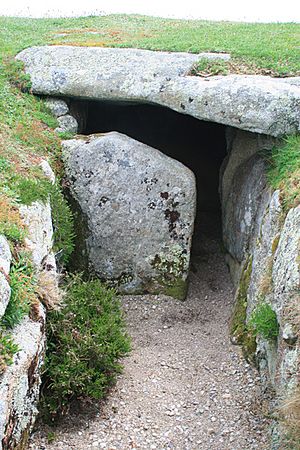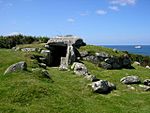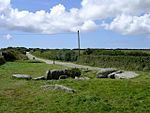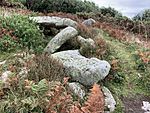Entrance grave facts for kids
An entrance grave is a special type of ancient burial place. These tombs were built a very long time ago, during the Neolithic (New Stone Age) and early Bronze Age. You can find them mostly in Great Britain.

These ancient burial monuments usually looked like a round mound. This mound had a stone border. Inside, there was a rectangular burial room. A narrow, stone-lined path led into this room. Entrance graves have been found in many places. These include the Isles of Scilly, west Cornwall, and southeast Ireland. They are also in southwest Scotland, Brittany, and the Channel Islands. People often call them the Scillonian Group. This is because most of them are on the Scillonian Islands.
History of Entrance Graves
Entrance graves in Britain are also known as Scillonian entrance graves. This is because most of these old burial sites are on the Isles of Scilly. These islands are about 25 miles (40 km) west of Cornwall. People first settled on the islands during the Neolithic era, around 2500 BC.
The burials on the islands date from the late Neolithic period. They continued until the Middle Bronze Age (about 2500–1000 BC). More than eighty entrance graves have been found on the Isles of Scilly. Many date to the late Neolithic period. They were still used until the early 8th century BC.
When archaeologists dug up entrance graves, they found interesting things. They found human remains, cremation urns, and pieces of pottery. For example, the Knackyboy Carn entrance grave on St. Martin's Island was excavated. It contained the remains of sixty or more people who had been cremated.
Entrance graves kept being built on the Isles of Scilly for many years. This was even after single burials became common on the mainland of Britain. Besides being used for burying people, these graves might have had other uses. Some think they were used for special ceremonies or cultural events. Others believe they marked land borders between different family groups.
What Entrance Graves Look Like
An entrance grave usually had a round mound. This mound was made of piled-up stones and earth. It was generally up to 25 meters (about 82 feet) wide. The edge of the mound was often marked with stones.
Inside the mound was a rectangular burial room. This room had a roof and was lined with stones. These stones could be large slabs or smaller stones fitted together. Many graves have a narrow entrance or passage. This path was also lined with stone slabs. The roof of the burial room was typically covered. It used small stones or large granite slabs. Some grave entrances were blocked by a very large stone.
Entrance graves could hold one person or many people. They are found alone or in small or large groups. Along with other types of large stone tombs, entrance graves are found in several places. These include western Cornwall, the Isles of Scilly, southeast Ireland, and southwest Scotland. They are also in the Channel Islands and Brittany. In Britain, most entrance graves are on the Isles of Scilly.
Gallery
-
Innisidgen, St. Mary's





